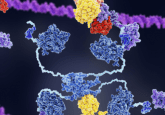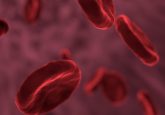Computational redesign of psychrophilic enzyme increases its optimum temperature

For the first time, researchers have successfully used computational simulations to modify an enzyme’s structure to increase the optimum temperature of a reaction.
Researchers at Uppsala University (Sweden) and the University of Tromsø (Norway) have increased the optimum temperature at which an enzyme operates using computer simulations to predict the number of structural changes needed. Manipulating temperature dependence of enzymatic reactions with computer simulations could be used to optimize enzyme properties for biotechnological and industrial applications.
Enzymes are involved in countless industrial processes, including brewing beer, baking bread, making cheese, manufacturing chocolate, producing biological detergents and making biofuels. Without enzymes, many of these industrial processes would not be possible and enzyme engineering has been an integral element to the success of these processes.
The researchers of this study have, for the first time, designed a new enzyme using computer simulations to increase the optimum temperature of an existing enzyme; they based their enzyme on a psychrophile α-amylase enzyme found in Pseudoalteromonas haloplanktis, a bacterium found in the Antarctic. Psychrophilic enzymes have been shaped by evolution to thrive in low temperatures down to -20°C, a temperature at which other enzymes would be inactive. These types of enzymes have higher catalytic activity at lower temperatures and a lower optimum temperature and melting point than enzymes in organisms that live at higher temperatures.
 New insights into HSV-1-induced encephalitis with cerebral organoids
New insights into HSV-1-induced encephalitis with cerebral organoids
A combination of anti-inflammatory and antiviral agents could improve treatment of encephalitis caused by herpes simplex virus-1 (HSV-1), according to new research utilizing cerebral organoids.
In many cases, the optimum temperature of cold-adapted enzymes does not coincide with their melting temperature and is not associated with protein unfolding, instead a different type of inactivation is taking place. In this psychrophilic α-amylase, the melting temperature is around 15°C higher than the optimum temperature. It is thought that the inactivation is due to a specific enzyme–substrate interaction that breaks at around room temperature.
Using computer simulations of a catalyzed chemical reaction, the researchers predicted that just 16 mutations could increase the optimum temperature of the psychrophilic enzyme by stabilizing the enzyme–substrate interaction. As the 3D structure of this α-amylase enzyme is similar to that of the porcine pancreatic α-amylase, mutations were taken from the porcine enzyme and inserted into the Antarctic variant.
The catalytic activity of the resulting enzyme was measured as a function of temperature, which demonstrated that the optimum temperature had increased by 6°C. X-ray crystallography was used to confirm that the structural changes predicted by the computer calculations had taken place.
Designing enzymes using computational models and predictions in this manner could streamline the process of creating enzymes with new and optimized properties by reducing reliance on labor-intensive experiments. Senior author Johan Åqvist (Uppsala University and University of Tromsø) remarked, “for example, this may involve creating new enzymes that catalyze chemical reactions not found in nature or changing their properties so that they can better cope with heat, cold, high pressure, increased salinity and so on. This area is, therefore, the subject of great biotechnological interest.”





